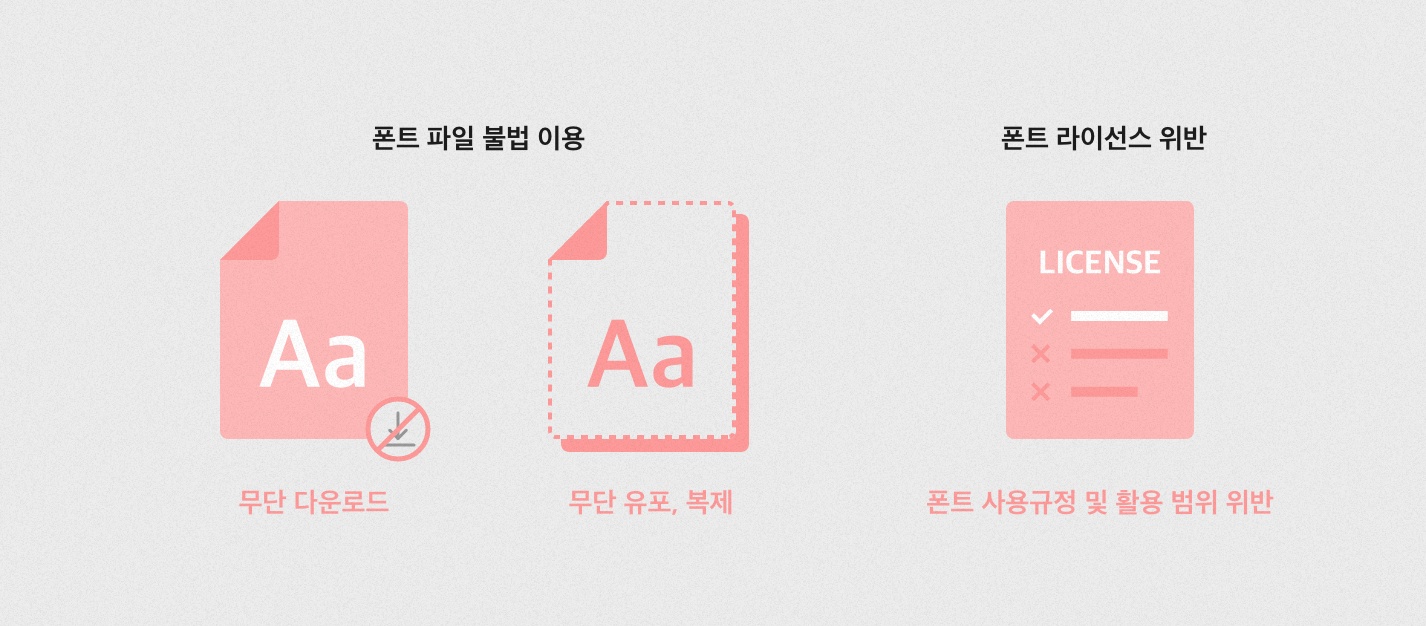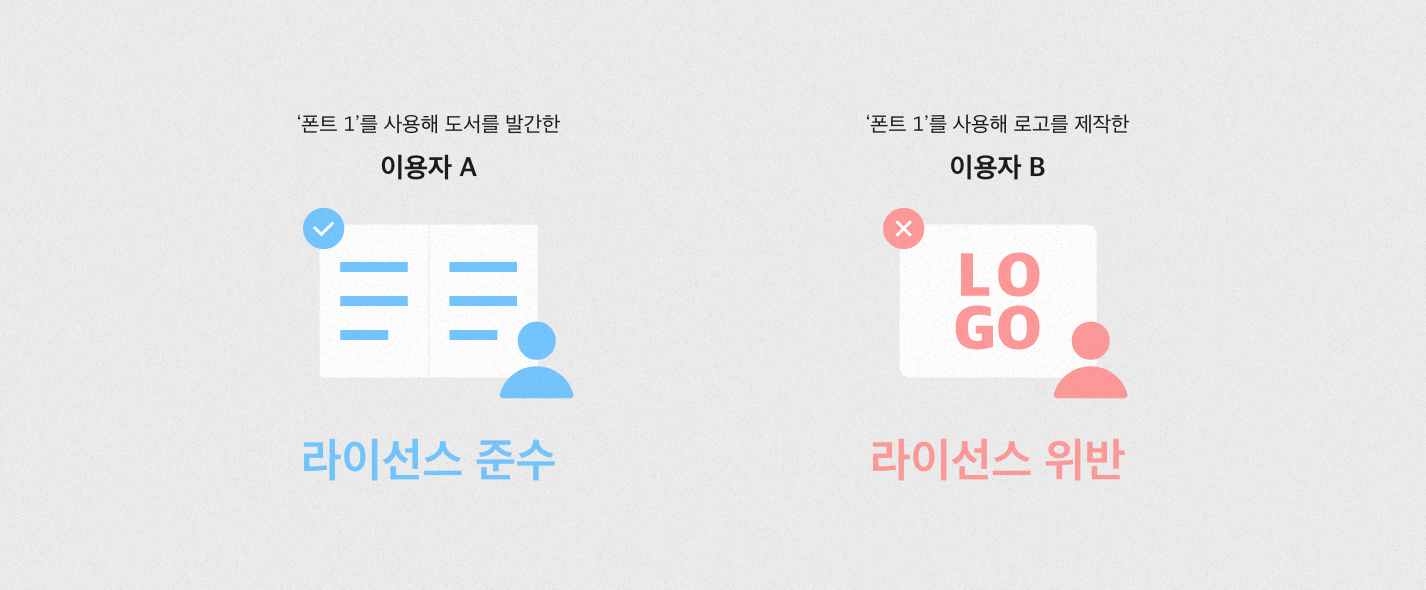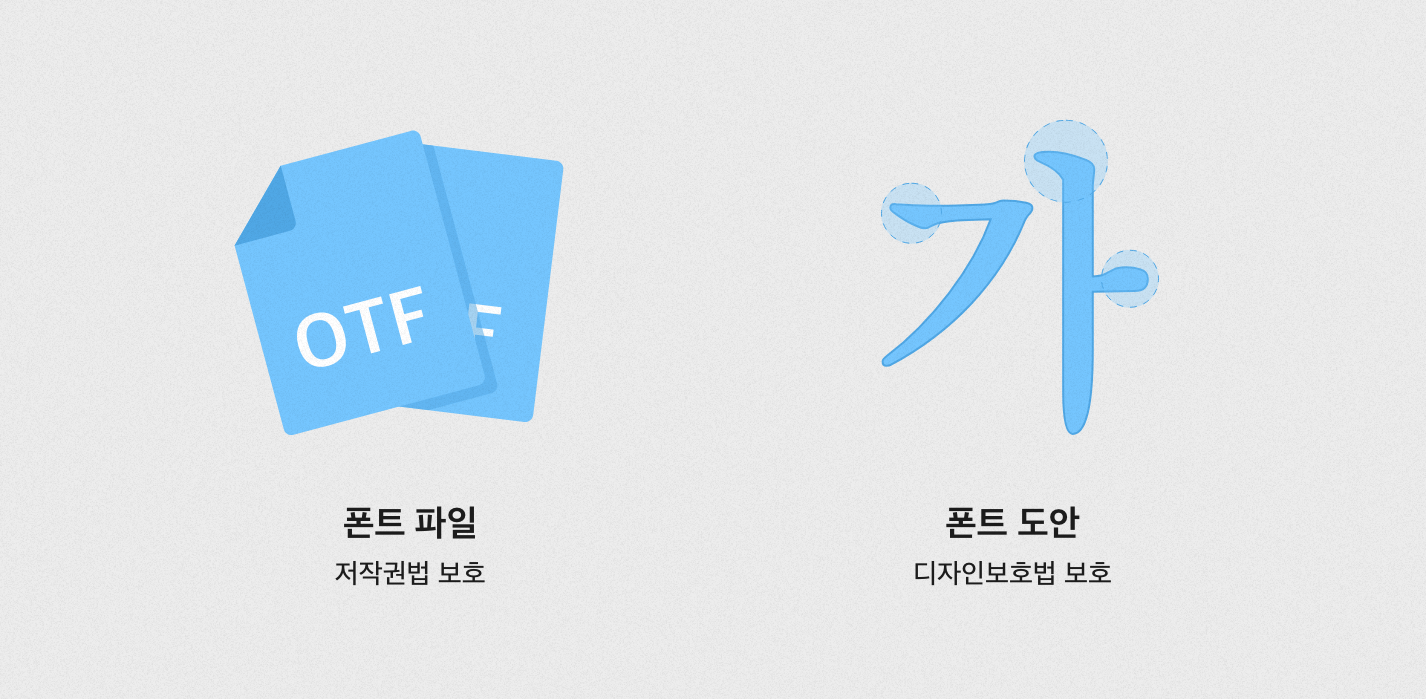아는 만큼 힘이 되는 폰트 저작권
폰트 저작권에 대한 이야기가 무성합니다. 직접 겪어보지는 않아도 어디서 한번쯤은 “폰트 회사에서 내용 증명을 받았다더라”하는 이야기를 들어보았을 텐데요. 이러한 이야기들을 근거로 “폰트는 무섭다”는 인식이 자라나고 있습니다. 그런데 실제로는 어떨까요? 어렵게만 느껴지는 폰트 저작권에 대한 오해와 진실을 속시원하게 이야기해보겠습니다.
폰트 저작권으로 합의금 장사를 한다?
저작권은 창작물을 만든 노력과 가치를 인정하며 그 권리를 보호하는 것을 말합니다. 폰트 역시 다른 창작물과 동일하게 저작권으로 보호하고 있는데요. 따라서 폰트 저작권을 침해할 경우 저작권법 제 46조에 의거하여 법적인 처벌을 받을 수 있습니다.
저작권법 제46조
① 저작재산권자는 다른 사람에게 그 저작물의 이용을 허락할 수 있다.
② 제1항의 규정에 따라 허락을 받은 자는 허락받은 이용 방법 및 조건의 범위 안에서 그 저작물을 이용할 수 있다.
③ 제1항의 규정에 따른 허락에 의하여 저작물을 이용할 수 있는 권리는 저작재산권자의 동의 없이 제3자에게 이를 양도할 수 없다.
저작권은 창작자로서 보장되어야할 당연한 권리입니다. 하지만 유독 폰트 저작권에는 ‘합의금 장사’라는 키워드가 따라 붙고는 하는데요. 창작자가 권리를 ‘보호’하기 위함을 벗어나, 합의금으로 ‘장사’를 하기 위해 저작권을 사용되고 있다는 부정적인 시선이 그 이유입니다.
이 문제를 보다 명확하게 설명하기 위해서는 폰트 저작권 침해 사례에 대해서 이야기할 필요가 있습니다. 모든 사례를 일반화하기는 어렵지만 폰트 저작권 침해는 크게 아래와 같이 2가지 측면으로 나누어볼 수 있는데요.
1) 폰트 파일 불법 이용
저작권자의 허락없이 폰트를 무단으로 다운로드 받거나 유포, 복제하는 것이 불법 이용의 대표적 사례입니다. 이는 폰트 저작권 인식이 낮았을 때 많이 발생했습니다. 저작권 위법임을 알고 사용하는 경우도 많았지만, 폰트 저작권에 대해서 미처 인지하지 못함으로 사용하는 사례들도 있었습니다.2) 폰트 라이선스 위반
폰트에는 라이선스라고 하는 사용 규정이 있습니다. 폰트의 활용 범위를 확인할 수 있는 일종의 사용 가이드라고 생각하면 이해가 쉽습니다. 이 내용을 근거로 크게는 유료, 무료 폰트 등으로 구분할 수 있습니다.

‘폰트 파일 불법 이용’은 논쟁의 여지 없이 저작권법 위반에 해당됩니다. 이러한 사례들은 저작권자 그러니까 창작자에게 심각한 피해를 초래하게 만듭니다. 비유하자면 저작권법 위반은 농부가 사계절 동안 피땀흘려 경작한 농산물을 훔쳐다가 김치를 담가 파는 일과 같습니다. 재주는 곰이 부리고 이득은 불법 이용자가 챙긴다는 말인데요. 다행히도 불법적인 이용 사례들은 저작권에 대한 인식이 점차 개선되면서 해소되고 있습니다.
폰트 라이선스 위반
오늘 중점적으로 이야기할 것은 ‘폰트 라이선스 위반’에 해당합니다. 폰트 저작권 분쟁의 대부분은 해당 사례에서 발생한다고 볼 수 있는데요. ‘합의금 장사’라는 부정적인 시각도 ‘폰트 라이선스’와 밀접하게 관계되어 있습니다.
‘폰트 라이선스 위반’의 문제는 ‘라이선스’를 제대로 인지하고 있는 사람이 많지 않다는 것입니다. 앞서 라이선스 내용을 근거로 유료와 무료 폰트로 구분할 수 있다고 말했지만, 이것은 반쪽짜리 설명에 불과합니다. 대부분의 폰트를 단순하게 유료, 무료 폰트로 구분하는 것이 어렵기 때문입니다.
일반적으로 생각하는 무료 폰트의 개념을 사례를 들어 설명해보겠습니다.
무료 폰트*로 알려진 ‘폰트 1’가 있습니다. 이용자 ‘A’는 ‘폰트 1’로 책을 발간 했고 이용자 ‘B’는 회사 로고를 제작했는데요. 이에 대해서 ‘폰트 1’를 제작한 업체는 이용자 ‘B’에 대해서만 라이선스 위반이라고 말합니다. 근거는 다음과 같습니다. ‘폰트 1’는 인쇄용, 영상용 등으로는 무료 배포했지만, BI/CI용으로는 사용이 불가능하다고 라이선스에 명시되었기 때문입니다.
*산돌이 운영하는 폰트 플랫폼 ‘산돌구름’은 위와 같은 폰트가 ‘무료폰트’와 오인지되지 않도록 ‘범위제한 무료폰트’로 표기하고 있습니다.

다른 사례를 하나 더 이야기해보겠습니다.
이용자 ‘C’는 문서 프로그램을 정품으로 구매했고 프로그램에 번들로 포함된 ‘폰트 2’를 사용했습니다. 이용자 ‘C’는 돈을 내고 구매한 프로그램에 포함되었기 때문에 ‘폰트 2’를 무료 폰트라고 생각했고, 작성한 문서를 PDF로 변환하여 홈페이지에 올렸습니다. 어느날 ‘폰트 2’를 제작 업체가 이용자 ‘C’에게 라이선스 위반이라고 말합니다. ‘폰트 C’는 문서 프로그램에서 사용할 때는 무료지만 PDF로 웹상에 게시하시는 것은 라이선스 위반이라는 것입니다.

이외로도 이용자들은 무료 폰트라고 인식했지만 라이선스 규정에 따라 저작권 논쟁에 휘말리는 사례들이 많은데요. 이는 앞서 이야기한 것처럼 ‘폰트 라이선스’를 제대로 인지하지 못했기 때문입니다. 공식 배포처에서 폰트를 내려받은 경우 페이지 내에 라이선스에 대한 설명이 명시되어 있지만, 그외의 방법으로 폰트를 사용하는 경우는 라이선스에 대한 설명을 접하기 어렵습니다.
단순히 이용자들의 부주의로만 떠넘기기에는 쉽게 인지하지 어려운 ‘라이선스’에도 문제가 있습니다. 산돌은 한국을 대표하는 폰트 파운드리로서, 불필요한 피해자를 만들지 않기 위해 복잡한 라이선스를 폐지*했습니다. 그 결과 산돌이 운영하는 폰트 플랫폼 ‘산돌구름’에 입점된 모든 폰트들도 별도로 라이선스 구분하지 않고 사용할 수 있습니다.
*[폰트 사용범위 통합] 캠페인 (링크)
하지만 아직 라이선스로 사용범위를 규정하고 ‘라이선스’를 인지하지 못한 이용자들에게 책임을 묻는 사례들이 분명히 존재합니다. 이를 배경으로 폰트에 대한 부정적인 시선이 쉽게 사라지지 않는데요. 산돌은 누구나 자유롭게 폰트를 사용할 수 있는 환경을 목표로 합니다. 이를 위해 라이선스 구분 폐지 외에도 사용자가 안심하고 폰트를 사용할 수 있는 문화를 만들어가고자 노력하고 있습니다.
나의 권리를 지키기 위해, 폰트 저작권 바로알기
앞서 이야기한 것처럼 대부분의 저작권 분쟁은 ‘폰트 라이선스’에서 비롯됩니다. 하지만 일부의 경우 이용자가 정당하게 폰트를 사용했음에도, 내용 증명이라는 수단으로 합의금을 요구하거나 폰트패키지를 판매하는 사례도 존재합니다. 바람직한 폰트 사용 문화를 위해서, 창작자의 저작권만이 아니라 폰트 이용자들의 권리 역시 지켜져야 할텐데요. 이에 알아두면 반드시 도움이 되는 폰트 저작권 정보를 모았습니다.
폰트는 저작권이 인정되지 않는다?
폰트는 저작권으로 보호되고 있습니다. 다만 보다 정확한 이야기를 위해서는 폰트를 ‘폰트 파일’과 ‘폰트 도안’으로 구분할 필요가 있는데요. 컴퓨터 프로그램에 해당하는 ‘폰트 파일’은 저작권에, 디자인에 해당하는 ‘폰트 도안’은 디자인보호법에 의거하여 보호됩니다.

저작권법 제2조
1. “저작물”은 인간의 사상 또는 감정을 표현한 창작물을 말한다.
2. “저작자”는 저작물을 창작한 자를 말한다
저작권법 제4조
1. 소설ㆍ시ㆍ논문ㆍ강연ㆍ연설ㆍ각본 그 밖의 어문저작물
2. 음악저작물
3. 연극 및 무용ㆍ무언극 그 밖의 연극저작물
4. 회화ㆍ서예ㆍ조각ㆍ판화ㆍ공예ㆍ응용미술저작물 그 밖의 미술저작물
5. 건축물ㆍ건축을 위한 모형 및 설계도서 그 밖의 건축저작물
6. 사진저작물(이와 유사한 방법으로 제작된 것을 포함한다)
7. 영상저작물
8. 지도ㆍ도표ㆍ설계도ㆍ약도ㆍ모형 그 밖의 도형저작물
9. 컴퓨터프로그램저작물
디자인권보호법 제2조
1. “디자인”이란 물품[물품의 부분, 글자체 및 화상(畫像)을 포함한다. 이하 같다]의 형상·모양·색채 또는 이들을 결합한 것으로서 시각을 통하여 미감(美感)을 일으키게 하는 것을 말한다.
2. “글자체”란 기록이나 표시 또는 인쇄 등에 사용하기 위하여 공통적인 특징을 가진 형태로 만들어진 한 벌의 글자꼴(숫자, 문장부호 및 기호 등의 형태를 포함한다)을 말한다.
폰트 저작권은 ‘폰트 파일’을 중요하게 생각합니다.
저작권으로 보호되는 것이 ‘폰트 파일’이라는 의미는 ‘폰트 파일’을 사용하지 않으면 ‘폰트 저작권 분쟁’과 무관할 수 있다는 뜻이기도 합니다. 폰트를 이용하려면 ‘폰트 파일’을 사용할텐데 어떻게 무관할 수 있냐고요?
외부 업체에 디자인을 의뢰한 경우, 의뢰자는 ‘폰트 파일’을 사용한 것은 아니므로 ‘폰트 저작권 분쟁’ 무관합니다. 만약 ‘디자인 결과물’에 사용된 폰트가 저작권에 문제가 된다면 해당 디자인 작업을 한 업체에 책임이 있습니다. 의뢰자는 외주계약서, 입금내역 등으로 이를 증명할 수 있습니다.
폰트 저작권을 제대로 인지하는 것이 중요한 이유는 ‘폰트 파일’을 이용하지 않은 사람들에게까지 저작권을 침해했다고 주장하는 사례들이 존재하기 때문입니다. 저작권자의 주장이 항상 옳은 것은 아닙니다. 따라서 불필요한 분쟁을 막기 위해서는 내가 사용하는 폰트의 저작권을 내가 알고 있는 것이 중요합니다.
Tip. 폰트 파일을 이용하지 않고 폰트를 사용하는 법
앞선 설명에서 “폰트를 이용하려면 ‘폰트 파일’을 사용한다”라고 말했는데요. 사실은 이 또한 정확한 설명은 아닙니다. ‘폰트 파일’을 이용하지 않으면서 폰트를 사용하는 방법이 존재하기 때문입니다. 폰트 플랫폼 ‘산돌구름’은 ‘폰트 파일’을 사용자의 컴퓨터에 내려받는 것이 아니라, 사용자가 선택한 폰트를 서버 호출을 통해 활성화하는 방식으로 서비스됩니다. 폰트 저작권은 ‘폰트 파일’을 기준으로 하기 때문에 ‘산돌구름’을 이용한다면 어떠한 경우에도 ‘저작권 논쟁’에 휘말릴 걱정이 없습니다.
산돌이 업계 최초로 클라우드 방식을 도입한 것 역시 ‘폰트 저작권’과 밀접한 이유가 있습니다. 폰트플랫폼 ‘산돌구름’ 이전의 폰트서비스는 폰트 파일을 이용자에게 직접 제공하기 때문에 폰트가 쉽게 유포되었습니다. 그 결과 폰트 저작권을 인지하지 못한 채로 무단 유포된 폰트를 사용한 이용자들이 저작권 위반으로 책임을 지는 일들이 많았습니다.
산돌은 더이상 불필요한 피해자가 발생하지 않도록 불법 이용이 불가한 방식의 서비스 제공을 고민했고, 그 결과가 현재의 클라우드 서비스를 기반으로한 산돌구름입니다.

폰트 파일 없이 클라우드 기반으로 서비스되는 산돌구름
산돌은 누구나 자유롭게 표현할 수 있도록, 제공자가 아닌 이용자에게 편리한 환경을 만들어갑니다. 작은 생각도 느낌에 머무르지 않고, 세상을 이롭게하는 큰 도약의 시작이 될 수 있도록 쉽고 명료한 서비스 제공할 수 있도록 차근차근 나아가겠습니다.
작성자: 산돌 BX팀 이용호